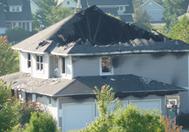- Lightning Protection Services /
- Residential & Light Commercial Lightning Protection Systems

Residential & Light Commercial Lightning Protection Systems
Class I – buildings under 75’ tall
These are five basic elements in a lightning protection system for a residential or light commercial buildings:

Air Terminals
Also known as “lightning rods” or “points”, these are the uppermost elements of the system, where the initial contact between the lightning strike and the system occurs. They are located at all portions of the roof area subject to direct strike, including ridges, flat roof edges, dormers, chimneys and other mechanical projections.
Conductors

Specially built lightning cables (of either copper or aluminum) that interconnect all air terminals and safely conduct the lightning strike to ground.

Bonding
Connections to mechanical, electrical and plumbing systems made to prevent side flashes (arcs) between these systems and the lightning protection system.

Grounding
Typically copperclad steel rods driven ten feet into the earth to serve as the safe discharge points for the lightning strike harmlessly into the earth. In some soil conditions these electrodes can be buried flat plates and buried cables.

Surge Arresters
Electrical devises installed on the structure’s electric, telephone, and data/video service entrances. These safely shunt dangerous over-voltage in these services to ground thus helping to prevent damage to the building electrical and electronic systems.

Special Items
These can include adjacent elevated objects (trees, antennas, flag poles) or such items as weather vanes or ornaments on air terminals.

